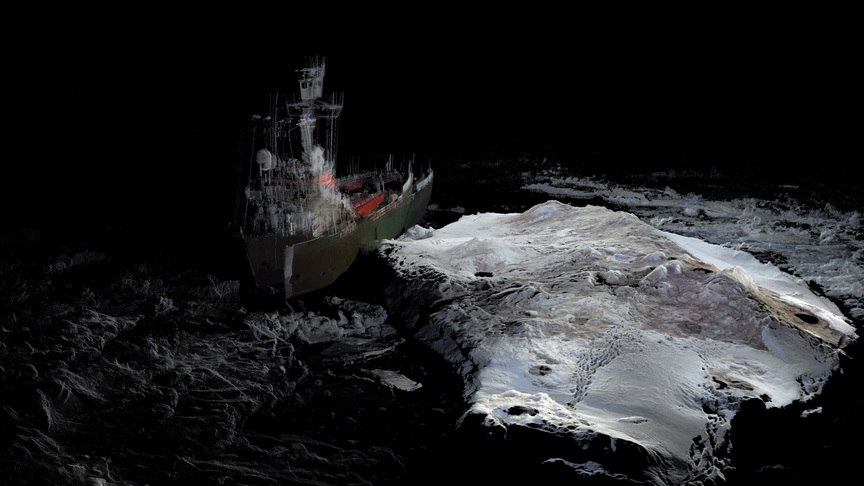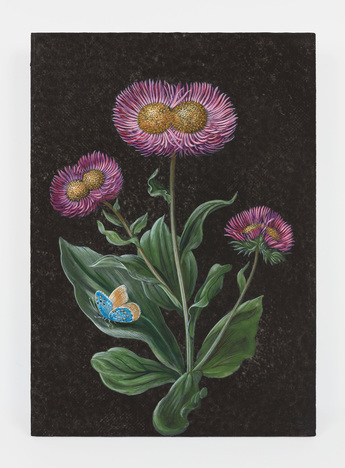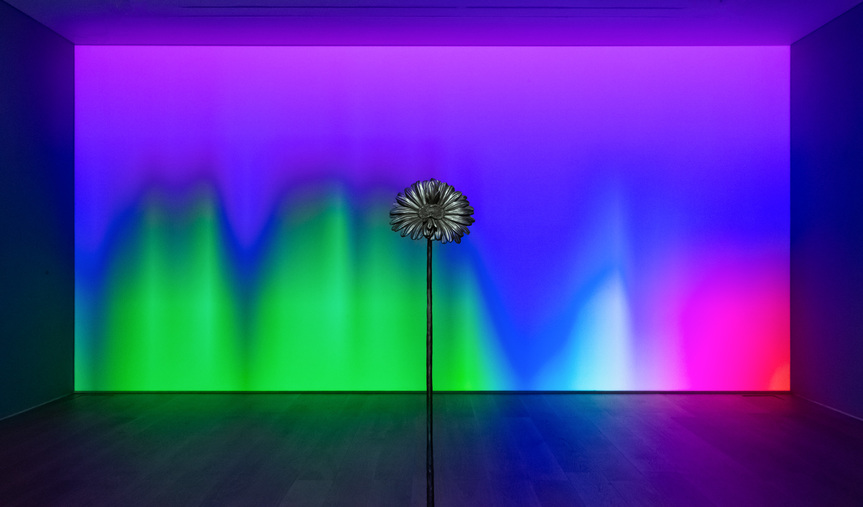
R
E
V N
E
X
T
Laurent Grasso’s surreal worlds immerse viewers in spaces of uncertainty and disequilibrium. Based in Paris and New York, the multidisciplinary artist draws upon elements of history, science, and mythology to challenge conventional perceptions as well as uncover unseen layers of one’s thoughts and surroundings. A graduate of the École Nationale Supérieure des Beaux-Arts in Paris and a 2008 laureate of the Marcel Duchamp Prize, Grasso was invited by Paris’s Musée d’Orsay in 2017 to create a new work for its exhibition “The Origins of the World: The Invention of Nature in the 19th Century” (2020–21). The resulting film, ARTIFICIALIS (2020), examines mutation, transformation, and humanity’s relationship with nature, and spurred a new painting and sculpture series, Future Herbarium (2020– ), showcased along with other works at his solo exhibition at Perrotin, Hong Kong. Lauren Long spoke with the artist about the inspirations and processes behind these new works, as well as his longstanding investigation into temporalities and the invisible.
ARTIFICIALIS features majestic and fantastical landscapes, ranging from dense forests to fire pillars in glaciers. What message does this film convey?
It’s interesting that you use the word “message” because I tried not to have one. I try to create an atmosphere to generate thoughts and questions without giving a precise answer. We already receive a lot of messages via all these information channels. I like exhibitions where you are slightly lost, which excites you cognitively.
The idea was to play with the notion of nature. Our concept of nature is no longer the same as from “The Origins of the World,” which was about evolution and how humans have represented nature until the 20th century, where you have humans on one side and on the other, nature. Today, with people like [anthropologist] Philippe Descola, we are understanding that this separation is no longer what we can work with. We are in a post-Anthropocene era, where everything is connected, and it’s difficult to understand what is completely natural and what has been transformed by humans. This is what I work with in the film, where it’s not possible to distinguish the old concept of nature and human.
Why this collage format of sceneries?
I’ve always worked with the past, the present, and the future, traveling through time for different references. For me it was interesting to partner with a historical museum like d’Orsay, a time capsule. [Museum president] Laurence des Cars was interested in the future, so she asked me to imagine a continuity for the show they were organizing about Darwin and the representation of nature.
I planned a project about exploration, and what it means today. Are we still able to explore? In a way we have been everywhere. The conclusion was to use new tools, like hyperspectral camera, LiDAR [light detection and ranging] scanner, 3D microscopic images, to create special effects to imagine these landscapes’ future. I collected a lot of materials via the video data bank, and it was difficult to decide the locations as we collected so many diverse and interesting ones, all related to metamorphosis and mutation. With the lockdown one year ago, I opted for a virtual shooting, which turned out well because I could use all the materials we collected. I started to work on this collage, not in a narrative way, but more where you can collect different signals from each location. We also began to work with Warren Ellis to create the music. I started to imagine this film as a living system with its own life.
Installation view of LAURENT GRASSO’s “ARTIFICIALIS” at Musée d’Orsay, Paris, 2020–2021. Photo by Claire Dorn. Copyright the artist / ADAGP, Paris & SACK, Seoul. Courtesy Perrotin.
The d’Orsay exhibition focused on historic scientific progression. Today we also have countless life-changing technological developments. How have you been impacted by technology?
As an artist it is necessary to be aware of new theories and technologies. I used LiDAR for ARTIFICIALIS. LiDAR captures a location [with laser]. You can see through the sea, such as underwater Mayan sites. My own work deals a lot with this idea of revealing the invisible through technology.
We are in this situation where we don’t know what the future is like. Some people are considering that post-disaster we may revert to being low-tech. I like this kind of paradox; I employ both painting, which is primitive, and scientific research. We are exposed to different forces, and as an artist you need to find the right balance. On one hand, we are fascinated by new technologies, virtualization, artificial intelligence, space exploration. Yet, we are also completely blocked by a virus. It humbles us; we can explore Mars but not the virus. It’s also political, where should we put all our energy or money? People are suffering, and in the meantime, it’s necessary to fund scientific research; there is a philosophical and also political decision to make.
The distemper-on-wood paintings in Future Herbarium depict two-headed flowers styled after 19th-century herbarium illustrations. What inspired this?
I often imagine phenomena in my films. Soleil Double (2014) had two suns, and I created moving clouds of pollen or smoke in Paris, using this strong visual to show viewers a new way of seeing reality when faced with the unknown. The flowers continue this. When you create an artwork, sometimes the simplest idea works; the double head shows this transformation, a bit strange, surrealistic, futuristic.
I found some [photos of] supposedly post-disaster [Fukushima] flowers. While I’m not sure of this theory, it’s interesting because I work with what kinds of stories people need to tell themselves. You have two sides: people need beliefs and they need to create mythologies. For example, for [the film] OttO (2018), I depict radionics and the scientist Georges Lakhovsky, who invented frequency devices to try to cure people [of cancer]. Radionics are fantasy objects, a bit alchemical, with the belief that you could transmit energy onto an object. But oftentimes these become reality because science is subjective; it is a decision to study or invent something linked to the scientist’s belief and personal decision. I like this association with fiction and science.
Why utilize the herbarium style?
It’s interesting to observe the history of nature’s representation and the idea of classification, the history of art and science. I often use historical sources, which exist in unconscious and collective memories, to install something familiar as a second layer. Instead of using imagery of our time, I use the past to create distance.
Your Perrotin show also features the light installation Solar Wind (2016– ), which translates real-time solar data into color waves.
I like to pair heterogenous objects and mix different periods to create a collage of different temporalities, something old with something futuristic. Solar Wind deals with solar storms, solar waves, and the sun’s magnetic activity. Solar wind is a real-time barometer of meteorology and space weather. There is this idea of invisible waves, and I like to imagine that the flowers of Future Herbarium are exposed to these waves in this imaginary space, reacting to the sun.
Your painting series Studies into the Past (2009– ) draws on cultural motifs from around the world. Several works at Perrotin portray Chinese elements, such as a triptych that depicts a red orb between an adaptation of Giuseppe Castiglione’s (1688–1766) portrait of the Qianlong emperor and a section similar to Wang Ximeng’s (1096–1119) A Thousand Li of Rivers and Mountains. What is your process for selecting motifs?
With each invitation I try to expand my collection of references, to share these with the local audience. I use this as a platform to instigate new research. You have this Italian [Jesuit] invited by the Chinese to be an official painter—that’s already a hybrid, a mixing of two ways of observing the world. I use this and mix further references to create something even more strange. I work with a [16th-century] manuscript, The Book of Miracles, illustrated with strange aerial phenomenon. It’s interesting as in the West we don’t have a lot of paintings, especially then, showing the eclipse or astronomical subjects.
When we initiated this project and I came to Hong Kong for the first time in 2003, we collected some interesting stories. I am interested by both sides [of the story and the aesthetics]. Sometimes we find existing motifs and other times we create them. For me, it’s to first have a conceptual approach; the exhibition is the final point of my process.
Lauren Long is ArtAsiaPacific’s news and web editor.
Laurent Grasso’s “Future Herbarium” is on view at Perrotin, Hong Kong, until April 24, 2021.
To read more of ArtAsiaPacific’s articles, visit our Digital Library.

















